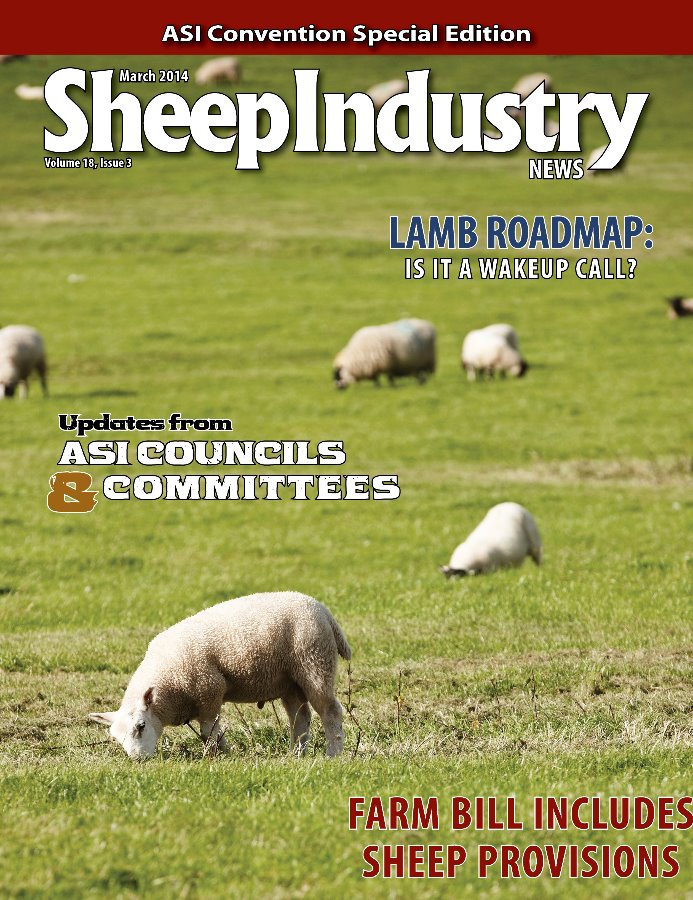
- March 2015
- President’s Notes
- Nearly 600 Participated in ASI Convention to Mark 150th Anniversary
- Smith: Animal Ag Needs to Protect Itself
- ASI Awards: Dedication to Sheep Industry
- Avalos Urges ASI to Support Livestock Reporting
- Wool Council Updated on Programs
- Wool Excellence: Mehta, Kott Honored for Service to Industry
- Market Report
- H-2A ‘Special Procedures’ Vital to Industry
- Breed Research Reported to PERC
- Legislative Council Shifts Spring D.C. Trip
- Let’s Grow Committee Begins to Build
- Pfliger Takes Reins as ASI President
- Buchholz, Ebert Elected to ASI Executive Board
- Stakeholder Committee Formed to Draft Sheep Station Defense
- Animal Health Updated on Bighorns, Scrapie
- Emerging Entrepreneurs Gain Momentum
- Sheep News Briefs
- Classified Ads
Smith: Animal Ag Needs to Protect Itself
Animal agriculture is under attack from groups that want to eliminate all animal use, but U.S. sheep producers can take steps that will help guard their flanks.
“There are 400 to 500 animal rights organizations with funding of $400 million a year to eliminate animal use for all purposes,” Kay Johnson Smith, president and CEO of the Animal Agriculture Alliance, told sheep producers at the ASI convention in Reno. “These people are selling nothing but propaganda.”
Smith cited the example of an undercover video, shot last spring by PETA (People for the Ethical Treatment of Animals), that alleged to show abuse during shearing on ranches in Colorado, Nebraska and Wyoming. The video was taken in April and May, but wasn’t released on YouTube until after the July 4 weekend, Smith said, to maximize impact and raise more money.
Smith’s Animal Agriculture Alliance connects with food industry stakeholders to arm them with responses to things like the shearing video. It helps consumers understand modern animal agriculture. And it protects the industry by exposing those who threaten the nation’s food security with damaging misinformation.
Smith said producers’ first line of defense is to know the opposition: who they are, what they do and what their tactics are. It used to be that organizations like PETA, Farm Sanctuary, Farm Animal Protection and the Humane Society of the United States competed with each other. Now, they collaborate and have strategic alliances. And they all promote veganism: Don’t eat animals, and don’t use any of their products, like wool or hides.
Smith said that animal rights groups do this with an active legislative agenda. They disparage all farm and animal industries. They create fear and mistrust in consumers. They engage in intensive fund-raising. All with the goal of driving demand and raising producer costs.
Undercover videos, Smith said, are big business for animal rights groups. While they used to sneak into farms to get videos, they now get hired to work on farms and ranches, giving them easier access. New video technologies and increasing venues on social media – Facebook, Twitter, Pinterest, Instagram, YouTube – facilitate exposure. And activists are given incentives, like the Humane Society’s whistleblower hotline, which offers a $5,000 reward for information that leads to an arrest and conviction for animal cruelty.
Drones are a new tactic that gives activists a way around so-called ag-gag laws. Smith cited one vegan journalist who used Kickstarter to raise $75,000 to buy drones and other equipment to investigate and show animal abuse.
In another new tactic, Smith said that PETA and HSUS are buying shares in agricultural and food corporations, and then showing up at annual shareholder meetings to introduce resolutions against animal use.
“No matter how good you are, some groups will disparage everything you do,” she said. “For example, PETA tells its acolytes, ‘There’s no such thing as humane wool.’”
However, she added, most of the public – 97 percent – eats meat and wears wool (and there are lots of backsliders in the other 3%) so animal agriculture really has a good base of support.
Still, producers need to arm themselves.
“Animal welfare, training, crisis management communications and advocacy must become part of your business plan,” said Smith, who offers these tips:
• Look at your property as if you’re on camera every second. Look at your practices from an outsider’s perspective. And identify your vulnerabilities.
• Find solutions to animal handling and care challenges by making sure you have a care and handling program and that you document your best management practices.
• Screen your job applicants and ask for and check references. When hiring, look for these red flags: Are they looking for temporary work? Are they willing to work for free? Do they have out-of-state license plates? Are they over- or under-experienced for the position?
• Find out if employees have recording devices.
• Train employees on proper handling procedures and hold regular meetings on animal care.

